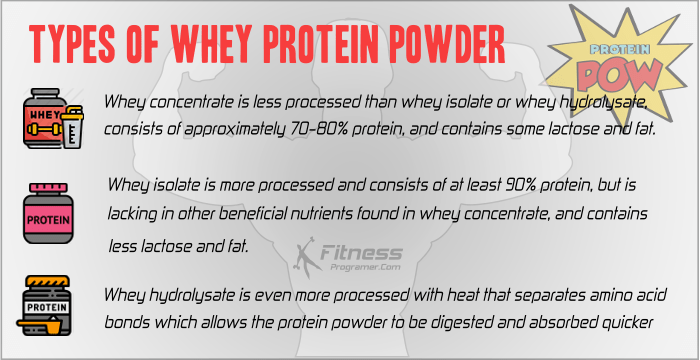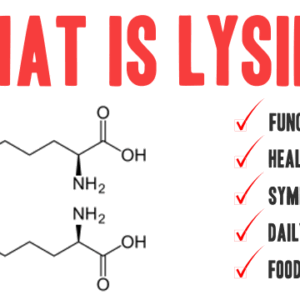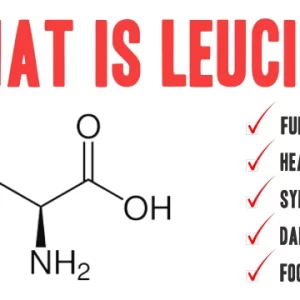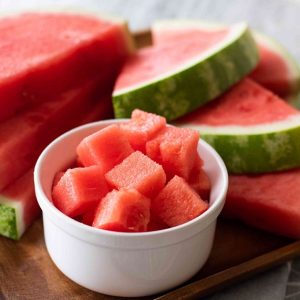What is whey protein?
There are two main proteins found in cow’s milk, casein, which represents about 80% of milk protein and whey which makes up the remaining 20%. During the manufacturing of milk products such as cheese the whey and casein proteins are separated in the curdling process and once upon a time the whey was thrown away as a waste product. Today whey is a highly sort after commodity and is used as the main ingredient to manufacture a variety of meal replacement and protein products.
WHY IS WHEY PROTEIN SO POPULAR AMONG ATHLETES ?
There are 3 main reasons why people prefer the benefits of whey protein;
- Whey is a complete, quality protein, with high net utilisation and little waste
- Whey contains the highest natural source of branched chain amino acids
- Whey is a fast acting protein
These are explained in more detail below.
The protein quality of a food is determined by how closely the ratio of amino acids (structural components of protein) in the food matches the human requirement and by how easily the protein is digested and utilised within the body. Whey is a high quality, complete protein which means that it is easily digested and absorbed by the body with little protein going to waste. Given that the essential amino acid composition of whey is similar to that of the human body there is a high conversion of dietary whey intake used in making of structural components within the body.
Of all of the natural sources of protein, whey contains the highest source of branched chain amino acids (leucine, isoleucine and valine). Branched chain amino acids are a group of essential amino acids that are used directly in the muscle building and repair process and therefore proteins with a large amount of branched chain amino acids generally have the greatest impact on muscle growth.
Whey is also a fast acting protein, which means that it is absorbed quickly into the bloodstream. It is widely believed that drinking a protein shake that contains whey shortly after a training session can speed up muscle recovery by making the essential and branched chain amino acids readily available to your muscles.
How to Choose a Whey Protein Product?
Don’t get sucked into buying the product with the most protein thinking it is the best, the amino acid profile (the makeup of the whey protein) is what determines the biological value not just the amount of protein. This will be reviewed in more detail in the future, in the short term you simply need to understand the following generalisation

What is protein quality?
To understand the quality of protein concept you must first learn some basic nutrition. Protein is made up of building blocks called amino acids. There are 20 different amino acids found within the body, 9 of which are consider essential and must be obtained through your diet. The other 11 amino acids are considered non-essential as these can be manufactured within the body as long as your diet is otherwise adequate.
The following table summarises the essential and non-essential amino acids. Don’t worry, unless you’re studying biochemistry you won’t need to remember them, they are listed simply because they are an important part of understanding the concept of protein quality.
| Essential Amino Acids | Non-Essential Amino Acids |
| hisitide* | alanine |
| isoleucine | arginine |
| leucine | asparagine |
| lysine | aspartic acid |
| methionine | cysteine |
| phenylalanine | glutamic acid |
| threonine | glutamine |
| tryptophan | glycine |
| valine | proline |
| serine | |
| tyrosine |
* Histidine is now listed as an essential amino acid as it is evidently required in childhood, even though its role in adulthood is less clear.
You can obtain all of the amino acids (both essential and non-essential) through a good diet, however it is the essential amino acids which determine the protein quality of a food.
Protein Quality of Food
There are 2 factors which determine the protein quality of a food:
- How well the essential amino acid content matches the requirement of the human body
- How easily the protein is digested and absorbed into the body for utilisation
In summary, the protein quality of a food is determined by how closely the ratio of essential amino acids in the food matches the human requirement and by how easily the protein is digested and utilised within the body.
There are a number of the methods of determining the protein quality of food. These methods work by either comparing the amino acid content of the food with the human requirement (through chemical estimation) or by measuring the amount of protein absorbed and retained by the body (Net Protein Utilisation).
The table below summarises the protein quality score of common foods using Net Protein Utilisation (NPU). The NPU is determined by measuring the amount of protein in a food and then accounting for any loses (in urine and faeces) after ingestion. The percentage of protein that is retained within the body is the NPU value. In summary, the higher the score the more effectively the protein will be absorbed and retained (and in theory utilised) within the body.
| Food Protein Source | NPU Value |
| Human Milk | 94 |
| Whole Egg | 87 |
| Cow’s Milk | 81 |
| Soy Beans | 67 |
| Rice | 63 |
| Wheat | 49 |
| Maize (corn) | 36 |
As can be seen in the table above, human breast milk has the highest protein quality (94% utilisation) which makes sense given the role of human milk in the growth and development of babies. This also helps to explain why eggs and cow’s milk are high in protein quality as again these foods provide infant animals the nutrition required for growth and development in the early stages of life.
As can be seen in the table above, human breast milk has the highest protein quality (94% utilisation) which makes sense given the role of human milk in the growth and development of babies. This also helps to explain why eggs and cow’s milk are high in protein quality as again these foods provide infant animals the nutrition required for growth and development in the early stages of life.
Supplementary protein powders often use milk proteins such as whey protein and casein, or egg protein as their main ingredient as these proteins are high quality and are easily utilised within the body to build muscle. To make it easy to compare the protein quality of food supplements to that of real foods a measure of biological value is used.
Biological Value of Protein
The Biological Value (BV) of protein is the measure of protein quality typically used within the body building industry. The biological value of protein can be measured using either of the methods (chemical estimate or Net Protein Utilisation) described above. The NPU method is considered the gold standard of measuring protein retention and in an ideal world all food and food products would use this method to determine their true protein Biological Value. Given however that this method is also both expensive and invasive it is rarely used in the food supplement industry.
A true Biological Value will be displayed as a percentage and uses the Net Protein Utilisation method to calculate how much protein is retained within the body. Theoretically you cannot have a true BV (or NPU) greater than 100%.
The other more common and cheaper method of determining BV is to use the chemical estimate technique. This technique allows you to easily compare the protein quality of food supplement items to that of whole foods. Given that eggs have the highest NPU value of any freely available food (seen in the table above), by comparing the amino acid profile of a specific food, to that of eggs, a chemical estimate of the relative Biological Value can be determined.
Using the relative BV technique, eggs are assigned a BV = 100. By comparing the amino acid profile of a test food to that of eggs a relative BV can be determined.
Whilst in theory you cannot have a true BV value great then 100%, it is possible to have a relative BV greater than 100. The best example is that of whey protein, which in its most natural state as whey protein concentrate has a relative BV of 104. In comparison some of the more desirable whey protein isolate products can have a relative BV of up to 159.
In summary it is not uncommon for whey protein supplements to have true biological value of almost 100%, making them the most complete and desirable sources of protein sold in the market place. This is achieved by isolating the essential amino acids that make up whey protein (found in cow’s milk) and removing the unwanted properties to ensure a higher utilisation within the body.
Types of whey protein
There are currently 3 different kinds of whey protein powder on the market: concentrate, isolate and hydrolysate.
Whey Protein Concentrate (WPC) – cheapest, most natural and complete form of whey protein. Comes with the highest percentage of fat and carbohydrate (lactose) and therefore takes longer to digest and there is a greater chance of gastric upset and bloating. Recommended for – beginner to moderate athletes and those looking to gain weight who otherwise have no trouble digesting dairy products.
Whey Protein Isolate (WPI) – greater percentage of protein per serve (less fat and carbohydrate), has the highest biological value (conversion of protein in the body) and the best overall effect on muscle growth. More expensive then WPC but cheaper then HWP. Recommended for – moderate to advanced athletes (majority of gym users), who wish to focus on muscle growth and recovery (not to be confused with weight gain) and/or those who are partially susceptible to dairy related symptoms (eg bloating, gastric upset).
Hydrolysed Whey Protein (HWP) – high protein percentage, absorbed the quickest, enabling quicker muscle recovery (really desirable for heavy trainers) with the lowest chance of side effects. It is the most expensive. Recommended for – advance athletes with high training volumes who need quicker recovery. Additionally is ideal for those who are very susceptible to dairy related symptoms (eg lactose intolerant).
Learn About Whey Protein Concentrate (WPC)
Whey Protein Concentrate also known as WPC is the foundation product of the whey protein range. Throughout this article we will discuss the pros and cons of using WPC as a protein supplement and what to look for when choosing the best protein product to suit your needs.
What is Whey Protein Concentrate?
Whey Protein Concentrate is essentially a dehydrated by-product (formally a waste product) of manufacturing cheese. During the production process of cheese, casein and whey proteins in milk are separated. If you then remove the water, you’re left with WPC.
Defining Whey “Concentrate”
WPC products offer whey protein in its most natural form, they do not however contain the highest amount (concentration per serve) of whey protein as the name suggests. Don’t let the name fool you, the term “concentrate” in regards to whey protein is in reference to its raw form, not the amount of protein.
Using WPC for Weight Gain and Muscle Growth vs Weight Loss
As a concentrate, whey protein acts as a moderate release protein where it is digested and normally absorbed within 2 hours of consumption, gradually feeding the body protein over this time. One advantage of whey protein concentrate is that it is very satiating, helping to satisfy hunger and prolong the feeling of fullness. Products that contain WPC can have up to 85% fewer calories than that of a typical meal and still help to satisfy your hunger which is specifically desirable for those trying to lose weight.
If weight loss is the goal, WPC products are typically used to replace a meal (ie breakfast, lunch or dinner) such that you get the feeling of fullness without over-consuming calories.
For those trying to gain weight, WPC is also very beneficial but instead it is used as a meal supplement to add protein and quality calories to your diet. Three balanced meals (breakfast, lunch and dinner) when supplemented with a whey protein product mid morning and again mid afternoon is generally enough to assist weight gain or muscle growth (please refer to any product specific label to achieve best results).
Benefits of Whey Protein Concentrate
One of the main benefits of whey protein concentrate is that in its natural form WPC delivers a complete protein where the natural amino acid profile is preserved. Whilst other forms of whey, Whey Protein Isolate (WPI) and Hydrolysed Whey Protein (HWP) may offer a higher protein content per serve and are more easily digested and absorbed, during the refining process some of the amino acids can be lost or modified in the process.
The other big advantage of WPC is the cost. Given that there is little processing and modification required, WPC products are the cheapest on the market, delivering quality whey protein at the most affordable price.
Disadvantages and Side Effects of Whey protein Concentrate
The most important is that WPC also contains a good dose of lactose (milk sugar), which has the potential to cause stomach upset and gastro-intestinal discomfort in some (not all) people. In particular WPC products are generally not recommended for people with lactose intolerance.
A common misconception however is that anyone who reports gastro-intestinal discomfort shortly after drinking WPC is lactose intolerant. Whilst the lactose content of WPC is likely to aggravate symptoms of people who have lactose intolerance, the side effects most commonly reported by WPC users is a result of ingesting the entire protein shake too quickly (particularly when taken immediately post workout) and/or not allowing your body time to adjust to a new food product.
To avoid the commonly reported protein shake bowel discomfort associated with WPC our best advice is to drink your protein shakes like a cup of coffee (slowly over 20 minutes), not like a tequila shot and this should settle down most stomach upsets. Additionally to help the bacteria in your bowel adapt to the new form of food, it is recommended that you slowly introduce protein shakes into your diet. Start day 1 with a small dose (ie quarter of recommended) and gradually build up to the recommended dose over a few days (ie quarter-dose, half-dose, full dose, twice daily etc).
If you have concerns about WPC or have experienced gastro-intestinal troubles with Whey Protein Concentrate in the past, switching to a quality Whey Protein Isolate (WPI), Hydrolysed Whey Protein or a Whey Protein Blend should help to overcome most gastrointestinal problems as well as offer additional whey protein benefits which are discussed in each of the relavent articles at the bottom of this page. The down side of course is that you will have to pay more.
The other advantage-disadvantage of WPC is the slower absorption rate. WPC is a moderate release protein which offers the benefit of ensuring your body receives a constant supply of protein throughout the day when taken in conjunction with a proper balanced diet. More recently however there has been a greater demand in the marketplace for fast release whey protein products (eg HWP and HWPI) which are designed to deliver a strong dose of protein quickly to help satisfy the increasing demand for blood proteins immediately post workout.
In an ideal world athletes would consume a well balanced diet in combination with either WPC or WPI throughout the day to ensure their body is always in positive nitrogen balance (ie there is always a supply of protein in the blood ready for when the body needs it) as well as a fast acting Hydrolysed Whey Protein Isolate (HWPI) immediately post-workout (absorbed within 20mins) to help satisfy any increase in protein demand. This combination however is costly and therefore a solution needs to be tailored not only towards your training goals but also your budget.
Choosing a Whey Protein Concentrate Product
Products advertised as Whey Protein Concentrate should normally be above the 75% protein mark if you’re looking for quality. Having said this it is not uncommon for weight and mass gain products to contain as little as 40% protein with the remainder of the serve made up of carbohydrates and fats.
A lot of people incidentally are deterred from using weight gain formulas based on the high portion of carbohydrate per serve, however these products as the name suggests are designed to help you gain weight, not make you look shredded and cut. When you are trying to gain weight, protein alone will generally have limited effects as you need a combination of quality protein as well as carbohydrate to promote insulin secretion and muscle growth. Most of the research suggests that protein without sufficient carbohydrate intake will have limited growth effects. Additionally the serving size of weight gain formulas is normally much higher, whilst you might only be getting 30% protein (ie 30g of protein per 100g serving), more than about 30g of protein in one serve is most likely going to waste anyway.
Our best advice when looking to buy any form of protein powder is to be clear about what your training goals are. Only when you’re clear about your goals can you really then decide what will be the best product to help you achieve that goal (as well as what sort of training you should be doing).
In summary be clear about your goals and don’t just look at the overall percentage of protein (protein serve per 100g) when choosing a product, but also the amount of protein per serve. Quality WPC products should give you at least 25g per serve.
As a general rule most WPC products are pretty much the same, any differences in price normally come through the cost of branding and through the added (often over-hyped) ingredients. Some brands of WPC will add certain ingredients to make them more appealing and sexy, but these products generally do little more than the basic formulas. The added ingredients become more important with WPI and HWPI products which are discussed in the relevant articles below.
One way to determine inferior whey products is that they normally do not mix well in water and will leave you feeling bloated. Unfortunately you normally won’t find this out until after you have bought the product. Some stores however will offer sample packs or let you try them first. Asking your fellow gym users about their experiences can also help.
Remember, don’t get sucked into buying the product with the most protein thinking it is the best, the amino acid profile (the makeup of the whey protein) is what determines the biological value not just the amount of protein.
Learn about Whey Protein Isolate (WPI)
Whey protein isolate also known as WPI is the most popular of all whey protein products sold in the gym supplement market today. It offers a high percentage of whey protein per serve and there is a significant reduction in the risk of side effects (mainly bloating) that are commonly associated with the more natural whey protein concentrate (WPC).
Throughout this article we will discuss the pros and cons of using WPI as a protein supplement and what to look for when choosing the best protein product to suit your needs.
What is Whey Protein Isolate?
As seen in the diagram below, after separating the dairy milk proteins into casein and whey, whey protein concentrate forms the foundation of all whey protein products. Whey protein isolate is then created by removing lactose (milk sugar) and fat from WPC through a process of filtration to craft a more refined, designer whey product.
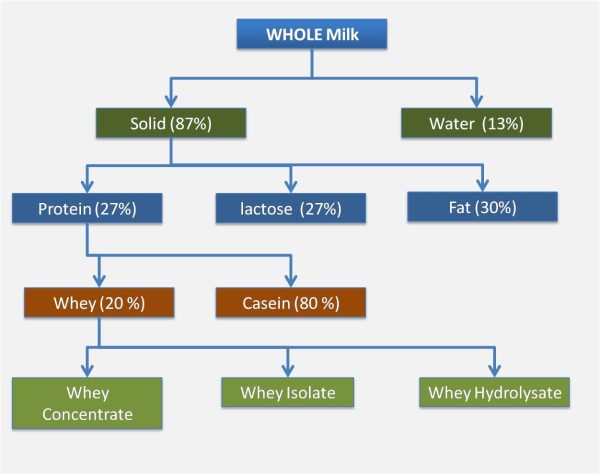
Which WHEY PROTEIN ISOLATE Filtration Method is best?
There are essentially 2 types of filtration methods used when refining WPI, ion exchange and cross-flow filtration. There are pros and cons to both methods and this is normally reflective in their price.
Whey protein ion exchange filtration is a chemical process where chemicals are used to breakdown the whey protein solution into individual molecules, which are then separated by an electrical charge. An advantage to this method is that ion exchange filtration will generally result in WPI products with the smallest amount of fat and lactose and the highest percentage of protein. The disadvantage is that during ion exchange filtration a number of the amino acids that make up whey protein are also broken down which results in them losing their biological value (ability to be utilized within the body to make protein and build muscle).
In summary, ion exchange whey protein isolate products will have a higher percentage of whey protein, but due to the breakdown of some amino acids it will also have a lower biological value. Essentially a higher protein percentage, but in a form that is slightly less useful to the body.
Cross flow filtration is a chemical-free process that uses a semi-permeable membrane to help filter a whey protein solution based on the size of its molecules. There are different degrees of cross-filtration that WPI products can go through to help isolate the whey protein molecules from unwanted ingredients such as fat and lactose. These include microfiltration, ultrafiltration and nanofiltration. What’s the difference? The pore size of the semi-permeable membrane and essentially the size of the molecules that can pass through the filter.
Microfiltration is the most basic form of whey protein isolate filtration and is also the cheapest. Products that go through microfiltration will still contain a small percentage of carbohydrate and fat.
Ultrafiltration is the next step up in filtration. The molecules that are small enough to pass through the membranes of microfiltration (above), may be too big in ultrafiltraion, which helps to produce a more refined product with less lactose and fat.
Nanofiltration is the most refined process allowing only the smallest of molecules (less than 1 nanometer) to pass through the filter. This type of filtration method can also be used to help separate individual amino acids to create a whey protein isolate product with a more desirable amino acid profile. Essentially this creates a higher biological value and a better conversation rate within the body. It’s also the most expensive.
From a practical product review perspective, the smaller the pore size used in the filtration process, the more refined the end product and additionally the more expensive the product will cost. For example products that undergo nanofiltration are more expensive that those that undergo ultrafiltration or microfiltration.
The main advantage of cross-flow filtration over ion exchange filtration is that the amino acids that make up whey protein are preserved in their natural form with the highest biological value resulting in a product with a high conversion to muscle mass. The disadvantage is that they will generally be accompanied by a slightly higher percentage of fat and lactose (although in the whole scheme of things this is normally is a negligible amount).
Overall whey protein isolate products have the highest biological value of all whey protein products, meaning that they produce the highest conversion into the making of structural body proteins and muscle mass. The type and the degree of filtration will ultimately determine the biological value of the product which is then normally reflected in the price.
Benefits of Whey Protein Isolate (WPI)
There are a few reasons why people are willing to spend a little more money and invest in WPI over the cheaper WPC products.
The main advantage of WPI products is that they deliver a good serving of whey protein without the associated carbohydrates or fat, which is most beneficial for those looking to increase/preserve lean muscle mass without gaining unwanted fat or weight.
Whey protein isolate products have the highest biological value of all proteins on the market, maximizing the efficiency in which the protein is converted within the body and reducing the amount of waste.
Additionally most WPI products are around 90% protein, delivering around 27g of protein per 30g serve. Most research suggests that we need to be aiming for at least 25g of protein per meal (particularly after a workout) to have the most anabolic (muscle growth) effect.
During the filtration process of WPI products the majority of carbohydrate has been removed, reducing the amount of lactose (normally to less than 1%) and hence reducing the risk of associated lactose related side effects (such as gastric upset), which are occasionally reported among WPC users, in particular those with those with lactose intolerance. Whilst WPI products are generally considered safer for people who experience gastric upset with whey protein related products, Hydrolysed Whey Protein Isolate (HWPI) products are most easily digested and therefore are the best option for people who experience gastric related symptoms.
Disadvantages and potential side effects of Whey Protein Isolate (WPI)
One disadvantage to WPI is that even with the lactose removed some people are still susceptible to gastric upset with WPI products due to the long chain nature of some of the amino acids (also present in WPC) that require intense digestion. For this reason Hydrolysed Whey Protein Isolate (HWPI) products were created to help moderate this digestion process and reduce the risk. During the hydrolysis process of HWPI, long-chain amino acids are pre-digested by enzymes such that the end product is much easier for the human body to digest and as a result there is a significant reduction in the risk of side effects.
Given that WPI and HWPI products have to go through a process of refinement, this adds to the manufacturing costs and hence you will pay more at the point of sale. Putting things in perspective however you will find that most WPI and HWPI products deliver quality protein for less than $3 per serve which is still cheaper and more convenient that cooking a meal of lean meat and eggs.
Our best advice is that once you’re sure that you’re committed to your training and you find a product that you like, buy in bulk (3kg or more) as it works out a lot cheaper in the long run.
One way to determine inferior whey products is that they normally do not mix well in water and will leave you feeling bloated. Unfortunately you normally won’t find this out until after you have bought the product. Some stores however will offer sample packs or let you try them first. Asking your fellow gym users about their experiences can also help.
Remember, don’t get sucked into buying the product with the most protein thinking it is the best, the amino acid profile (the makeup of the whey protein) is what determines the biological value not just the amount of protein.
Learn About Hydrolysed Whey Protein (HWP)
Hydrolysed Whey Protein, also known as HWP is a highly desirable form of whey protein that is absorbed quickly and easily into the body making it the ideal pre or post workout protein supplement. Whilst they are a number of benefits to HWP, there are also a number of limitations and therefore throughout this article we will discuss both the pros and cons of using HWP as a protein supplement, the differences between HWPI and HWPC and what to look for when choosing the best protein product to suit your needs.
What is Hydrolysed Whey Protein (HWP)?
Hydrolysed Whey Protein is then created through a process of hydrolysis where the amino acids (predominately the long-chain amino acids that make up whey protein) are pre-digested (broken down) by enzymes such that the end product is absorbed into our bloodstream much quicker. The pre-digested product is also much safer for human consumption with a significant reduction in the risk of gastrointestinal side effects.
What’s the difference between HWPI and HWPC?
There are 2 types of HWP, hydrolysed whey protein concentrate (HWPC) and hydrolysed whey protein isolate (HWPI). The difference between them is the point of hydrolysation. To make HWPC you only need to hydrolyze the WPC, where to make HWPI you need to isolate the whey protein first and then hydrolyze it.
Hydrolysed whey protein concentrate (HWPC) vs Hydrolysed whey protein isolate (HWPI ) – Which is Better?
Assuming that we are comparing apples with apples and the hydrolysis process used to make both is the identical (ie using the same enzymes, in the same environmental conditions, for the same amount time) comparing HWPI with HWPC is the same as comparing Whey Protein Concentrate to Whey Protein Isolate. For athletes seeking a fast acting Whey Protein for pre or post workout purposes, they would be best served by using a HWPI, as isolates are traditionally digested faster and contain more protein per serve. Additionally Hydrolysed Whey Protein Isolates have lower amounts of lactose and fat in comparison to Hydrolysed Whey Protein Concentrates. Unfortunately the process of hydrolysation leaves a bitter taste in your mouth and therefore HWPC products tend to taste better then HWPI as they contain a higher percentage of fat and sugar. Whilst hydrolysed whey concentrates may taste better, the fat content slows down the absorption rate and therefore it takes longer for the amino acids to enter the bloodstream.
Which is better? Well that depends on what you’re taking it for. Given that most people who take hydrolysed whey protein products do so for the fast acting protein, HWPI is generally the better option. Fortunately most HWPI products on the market today take advantage of modern food technology to make them taste better (although as a result, may contain artificial sweeteners). Once upon a time to drink HWPI, you had to hold your nose, it was awful!
Whilst Hydrolysed whey protein isolate products are typically the most desirable option they are also represent the most expensive products on the market. Depending on your training goals, sometimes this extra cost is unwarranted and therefore you should consider both the pros and cons of hydrolysed whey protein discussed below before jumping to conclusions.
TIP: don’t mix HWPI with anything other than water, mixing pure HWP products with milk for example will slow down the absorption process defeating the point of taking it in the first place.
Advantages of Hydrolysed Whey Protein
One of the main advantages of HWP over the more natural WPC and WPI is that it is safer for human consumption. A commonly reported side effect of ingesting whey protein is that in some people it can cause gastric discomfort, constipation, cramping or bloating.
One of the reasons people often experience these symptoms is that the digestive system has to work hard to breakdown the many long-chain amino acids that make up whey protein. Hydrolysed whey protein is already pre-digested by enzymes and therefore it is much easier on the digestive system. Additionally HWP is absorbed much quicker (some products are absorbed within 20mins of consumption). In comparison the more natural WPC can take up to 3-4 hours to fully digest.
Another cause of gastric upset is the strong dose of lactose associated with whey protein products given that they originate from dairy milk. To overcome this problem whey protein isolate products were created to deliver a higher percentage of protein and smaller percentage of lactose. Hydrolysed whey protein Isolate takes this one step further by breaking down the long chain amino acids making it even easier on the stomach.
Given that HWP is the easiest form of whey protein to digest and is the least likely to cause side affects, HWP (and in particular HWPI) is the most common form of whey protein used in baby formula and medicinal protein products.
Hydrolysed whey protein shakes consumed in the gym, trend or friend?
The main reason why Hydrolysed whey protein products are popular among athletes in the gym is that they typically offer a strong dose of protein, which is absorbed quickly into the blood stream making them an ideal pre/intra/post workout protein supplement.
A recent study conducted in Australia (2008) concluded that Hydrolysed Whey Protein was more effective in muscle recovery immediately post workout when compared to other whey protein products, which arguably makes them more desirable.
In summary the main reason people like HWP products is because they contain the fastest acting source of whey protein, which elicits the greatest results when consumed immediately post workout. Unfortunately the benefits of consuming HWP at other times of the day are less convincing and are discussed in more detail below.
Limitations and Disadvantages of Hydrolysed Whey Protein
Whilst at this point we might have you thinking that that HWPI are the best products on the market and therefore they are the only products you should be looking at, that would be wrong. There are no doubt advantages to using HWP products, particularly when consumed immediately post workout (as discussed above), but there are also a number of disadvantages and this is where if you’re smart you can save a lot of money.
The first disadvantage is the cost, these products are normally twice as expensive as whey protein concentrate and this is easily justified by the extra processing that is required to manufacture these products. The question that needs to be ask is, are they worth the extra cost?
The main advantage of HWP products is that that they offer a fast acting protein, but in order to do this the long-chain amino acids need to be broken down through a process of hydrolysation. The problem with this is that when you breakdown these amino acids they lose some of their biological value meaning that they become less useful to body, particularly when trying to build muscle. So whilst HWP products offer the opportunity to deliver protein quickly, as a trade off you make the sacrifice of delivering a protein of lower biological value (less desirable for building muscle).
This is not to say that HWP should be dismissed, but instead use them for the purpose in which they were intended, a post workout protein hit. Now here’s the most important thing to remember about HWP and this is where you can save money. Pure HWPI (the expensive stuff) is only really beneficial when taken just before, during or after a workout. If you taking pure HWPI at any other time throughout the day (ie more than 3 hours before or after training), your money could be better spent. Sure your still getting protein, but at other times of the day you would be better off using a cheaper, better quality protein (higher biological value), such as Whey Protein Isolate to ensure you have enough long chain amino acids required to build muscle.
In an ideal world, if you are a serious athlete, you would use a quality HWPI immediately post workout (for an instant protein boost) in combination with a quality Whey Protein Isolate (WPI), Whey Protein Concentrate (WPC) or a whey protein blend (WPI + WPC) a few times throughout the day to ensure you get adequate amounts of all the amino acids you require for strength and muscle mass gains. An alternative is to purchase a whey protein blend that offers both.
One big mistake that uninformed (or misinformed) athletes make in the gym is that they spend the big bucks on 100% pure HWPI and drink it during or after their workout, but then think that’s all they need to do. If you read the article on post workout nutrition you will learn that the most important nutrient immediately post workout is carbohydrate, not protein and therefore if you’re only consuming protein immediately post workout and not addressing the glycogen window, you’re wasting your money.
Essentially our best advice around nutrition for athletes is to get your basic nutrient timing right first before you starting investing in the top shelf protein products. Additionally when using HWP products they are best used in combination with a more complete protein such as WPI or WPC throughout the day as discussed above. They generally don’t deliver the best results when used in isolation.
What is the Degree of Hydrolysis (DH)?
To understand hydrolysis you first need to understand that whey protein is made up of a series of short, medium and long chain amino acids which are held together through a series of peptide bonds. During the process of hydrolysis, specific enzymes are added to isolate and break these peptide bonds. Depending on the type of enzymes added and the processing conditions, different amino acid sequences can be produced. This amino acid profile then determines the nutritional and functional characteristics of the hydrolysed whey protein product.
The degree of hydrolysis (DH) refers to how much of the protein has been pre-digested. An overall DH value of 10% suggests that 10% of all the available peptide bonds have been hydrolysed (pre-digested). To make it more confusing however sometimes the DH value maybe in reference to how many of the amino acids have partially broken down. 100% pure hydrolysed whey protein isolate for example does not mean that the formula has been entirely broken down (if so it would be worthless), instead it means that the product only contains hydrolysed whey protein isolate and does not contain any traces of WPC or unhydrolysed WPI.
In our experience the key is to not read too much into the degree of hydrolysis, you time is generally better spent modifying your training program to maximize the results and not just doing an exercise for the sake of doing it. Every rep and set has a purpose and only when you take this approach can you optimize your returns.
One final word on the degree of hydrolysis, of all the whey protein formulas, 100% pure hydrolysed whey protein isolate will be absorbed the quickest, but it’s also the most expensive (and most bitter tasting). For the general population, beginner and intermediate athletes, this extra investment is most likely unwarranted, using WPI will save you money and often deliver better results. For those advanced athletes who are set on HWP, we recommend 100% pure HWPI, you’ll pay for it, but if everything else in your diet and workout is optimized, you will notice the difference.
What’s the best protein powder (for you)?
There is no magic bullet solution that will work for everyone. It ultimately depends on your current diet, physic and your training goals. To achieve the best results, you must tailor the solution to be specific to your needs.
- Whey protein concentrate (WPC)
- Hydrolysed whey protein (HWP and HWPI)
- Whey protein isolate (WPI)
- Whey protein blends (WPC + WPI or WPC + HWPI)
Products advertised as Whey Protein Concentrate should normally be above the 75% protein mark if you’re looking for quality. Having said this it is not uncommon for weight and mass gain products to contain as little as 40% protein with the remainder of the serve made up of carbohydrates and fats.
A lot of people incidentally are deterred from using weight gain formulas based on the high portion of carbohydrate per serve, however these products as the name suggests are designed to help you gain weight, not make you look shredded and cut. When you are trying to gain weight, protein alone will generally have limited effects as you need a combination of quality protein as well as carbohydrate to promote insulin secretion and muscle growth. Most of the research suggests that protein without sufficient carbohydrate intake will have limited growth effects. Additionally the serving size of weight gain formulas is normally much higher, whilst you might only be getting 30% protein (ie 30g of protein per 100g serving), more than about 30g of protein in one serve is most likely going to waste anyway.
Our best advice when looking to buy any form of protein powder is to be clear about what your training goals are. Only when you’re clear about your goals can you really then decide what will be the best product to help you achieve that goal (as well as what sort of training you should be doing).
In summary be clear about your goals and don’t just look at the overall percentage of protein (protein serve per 100g) when choosing a product, but also the amount of protein per serve. Quality WPC products should give you at least 25g per serve.
As a general rule most WPC products are pretty much the same, any differences in price normally come through the cost of branding and through the added (often over-hyped) ingredients. Some brands of WPC will add certain ingredients to make them more appealing and sexy, but these products generally do little more than the basic formulas. The added ingredients become more important with WPI and HWPI products which are discussed in the relevant articles above.
One way to determine inferior whey products is that they normally do not mix well in water and will leave you feeling bloated. Unfortunately you normally won’t find this out until after you have bought the product. Some stores however will offer sample packs or let you try them first. Asking your fellow gym users about their experiences can also help.

